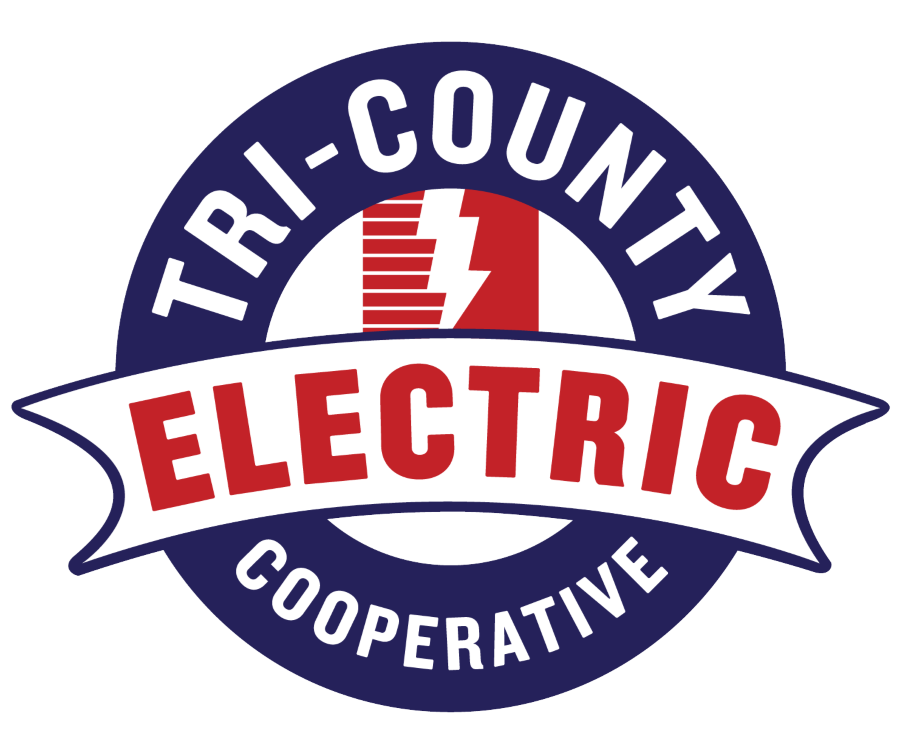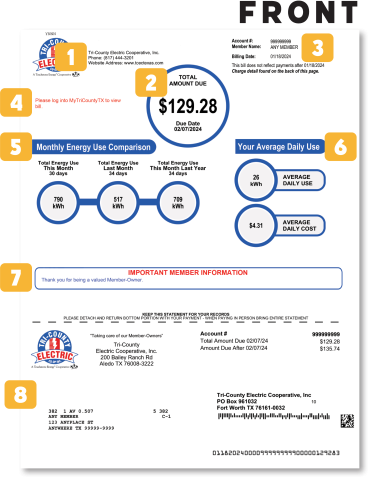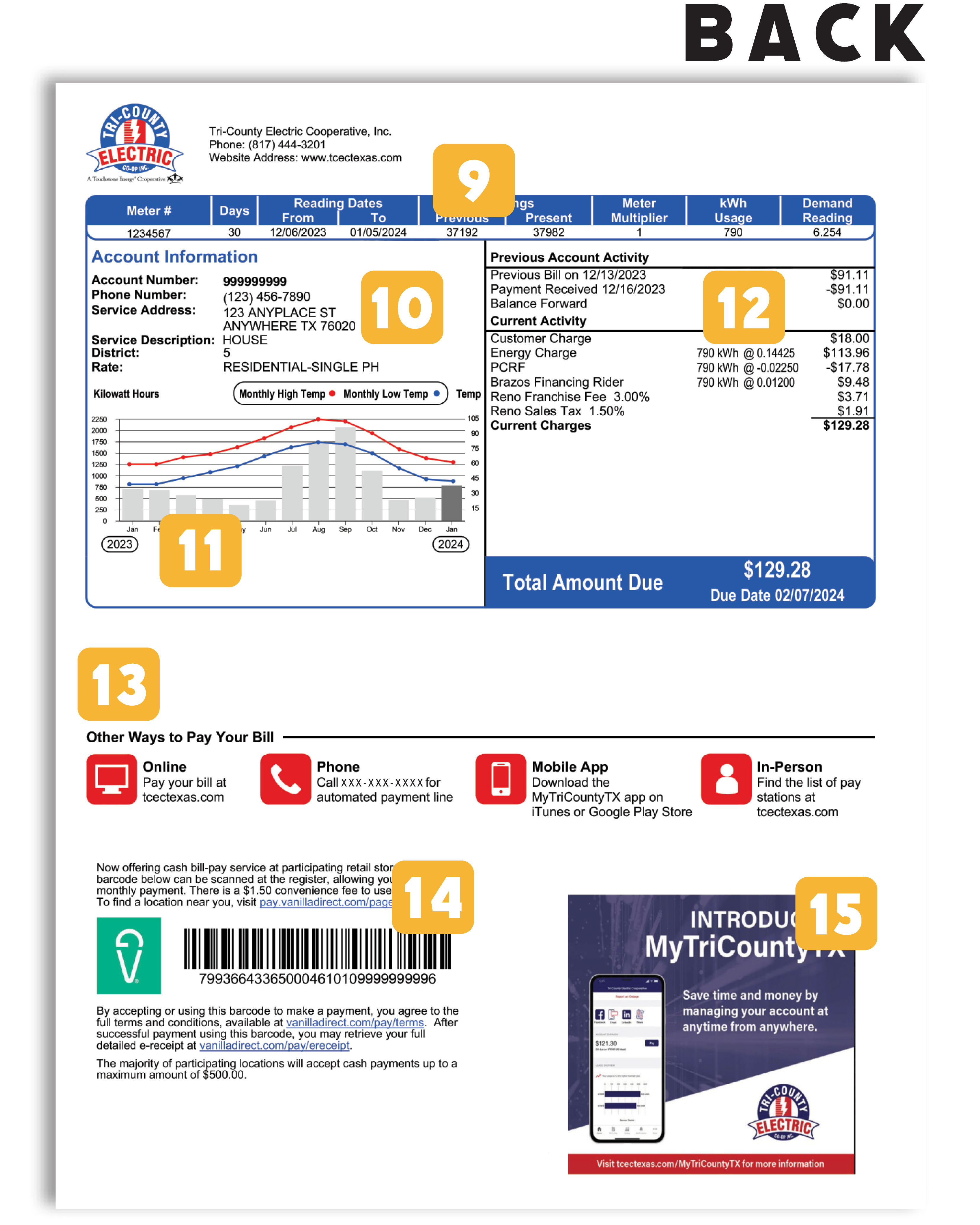How to Read Your Billing Statement
FRONT
1. Contact Information: Tri-County Electric Cooperative phone number and website.
2. Total Amount Due: Summarizes the total amount due on this statement including the due date. Auto Pay will be indicated if you participate in automatic debit/credit card or bank draft.
3. Your Account Information: Your account number and bill date for the current bill.
4. Account Message Center: Important messages about capital credit allocations, credit card expiration dates, or past due amounts.
5. Monthly Usage Comparison: A quick snapshot of your current billing period usage and how it compares to past usage.
6. Daily Usage: Average energy used per day for the current billing period, along with average daily cost.
7. Tri-County Message Center: Read important messages about services, notices and events.
8. Payment Stub: Detach and include this portion of the bill if you're paying by mail, in-person, or using one of our drop-boxes.
BACK
9. Meter Information: Meter number, days of service, reading dates, meter readings, and total energy used in the current billing period.
10. Account Information: Account number, main phone number, service description, board district and rate.
11. Energy Comparison Graph: See your usage trends for the past 12 months, along with the average monthly high and low temperatures.
12. Account Activity: A detailed breakdown of previous balance, payments, current charges and current total amount due.
13. Ways to Pay: Your co-op, your way. We have many ways to pay your bill so you can do what works best for you.
14. Cash Bill-Pay: Use this bar-code to pay your bill at participating retail stores.
15. Bill Messages: More space to keep you updated on news and information from your co-op.
Billing FAQs
Members may see the following items listed on their bill: Customer Charge, Energy Charge, PCRF, outdoor lights, and applicable fees and taxes. These charges are not new and have always been on member bills labeled as one Electric Charge.
This monthly service fee is an availability charge that covers a portion of the fixed costs of providing electric distribution service, including maintenance and operations. The remainder is recovered in the Energy Charge, which is a variable charge based on electric use consumed.
The monthly Customer Charge for residential members is $18.00 for single-phase service and $30.00 for three-phase service.
The Energy Charge includes power costs and distribution costs beyond what is collected in the monthly Customer Charge.
The rate for residential members is 14.425 cents/kWh consumed, which includes 10.5 cents of budgeted power costs. Only 3.925 cents stays with Tri-County Electric Co-op to cover operating expenses.
Power Cost Recovery Factor (PCRF) is a rate mechanism used to true-up the actual cost of wholesale generation and transmission services versus budgeted costs. PCRF is a pass-through component, meaning Tri-County Electric Co-op passes wholesale generation and transmission costs to our members at our cost without markup.
Beginning in January 2023, a 1.2 cents per kilowatt-hour (kWh) charge has been included on all member bills to recover costs related to Winter Storm Uri. This charge, known as the Brazos Financing Utility Plan Rider, is reviewed every six months to ensure it continues to support TCEC’s loan repayment.
A hardship fund was established as part of the Brazos bankruptcy proceedings to help offset these costs for qualifying lower-income members.
Applications are open for residential members who meet eligibility criteria. Eligibility requirements and application instructions can be found on the program website.
Members may see charges for taxes and fees. These charges are collected on behalf of the city based on contractual agreements between the city and the co-op. All money collected is passed through and does not stay with the co-op.
These charges are not new and have been collected on behalf of the city. Members may notice taxes and fees now due to the bill itemization.
Our member service team is here to help. All we ask is that you contact your co-op. We are here to help.
We also partner with local community organizations that may help with payment assistance.
Tri-County Electric Co-op is dedicated to educating members on energy management and empowering smart energy use.
Members can track daily electric use online through MyTriCountyTX.


